The views expressed in our content reflect individual perspectives and do not represent the authoritative views of the Baha'i Faith.
Does just being alive make you feel wonderful? Does just being alive expand your consciousness and sometimes tip you into bliss? If not, would you like to feel that way?
If your answer is yes, don’t just wake up and smell the coffee – we all need a way of waking up more deeply to the promptings of our inner spirit.
That wake-up call involves inhaling the mystic perfume of all the prophets and founders of the world’s great Faiths, such as Krishna, Buddha, Moses, Christ, Muhammad and Baha’u’llah. Their unparalleled wisdom teaches us how to deal with challenges and change, and helps us focus on the eternal value of our lives.
RELATED: The 3 Great Early Religions of the East
We tend to think of those divine messengers as separate, diverse entities who founded different religions at different times. But what if they’re not separate at all?
The teachings brought to humanity by Baha’u’llah, the prophet and founder of the Baha’i Faith, encourage us to see all of those holy messengers as one:
… view all the Prophets and Messengers of God as one soul and one body, as one light and one spirit, in such wise that the first among them would be last and the last would be first. For they have all arisen to proclaim His Cause and have established the laws of divine wisdom.
This series of essays explores that tremendous, revelatory theme by investigating what each of the great Faiths has to say about achieving oneness. In this article, we’ll examine the quest for unity in one of humanity’s oldest and most venerated Faiths, Hinduism.
Hindu Teachings on Oneness
What is the key passage in the Hindu teachings that offers core spiritual insights? Perhaps it’s this, from the Hindu Upanishads:
Like two birds of golden plumage, inseparable companions, the individual self and the immortal Self are perched on the branches of the self same tree. The former tastes of the sweet and bitter fruits of the tree; the latter, tasting of neither, calmly observes.
The individual self, deluded by forgetfulness of his identity with the divine Self, bewildered by his ego, grieves and is sad.
But when he recognizes the worshipful Lord as his own true Self, and beholds his glory, he grieves no more.
Baha’u’llah, in his Book of Certitude, revealed in two days and nights in 1862, explained:
It is clear and evident to thee that all the Prophets are the Temples of the Cause of God …. If thou wilt observe with discriminating eyes, thou wilt behold them all … soaring in the same heaven, seated upon the same throne, uttering the same speech, and proclaiming the same Faith …. Should any of them say; “I am the return of all the Prophets,” He verily speaketh the truth. In like manner, in every subsequent Revelation, the return of the former Revelation is a fact …
We are united by the reality of one God, one Holy Spirit, a series of messengers, and our one human family.
But there are also the teachers who receive love and light from the revelations of the prophet’s original teachings and go on, in turn, to reflect that love and light in their lives. Their spiritual attributes shine out for all to see. They walk the talk. That’s you and me, if we will it and act on it.
In the desert of materialism there are many wells of sweet water from both the messengers, and their true reflectors, who can quench our spiritual thirst. That sweet water is now more accessible than ever before in history. Baha’u’llah wrote: “Peerless is this Day, for it is as the eye to past ages and centuries, and as a light unto the darkness of the times.”
The Ancient Hindu Teachings and Their Continuing Truth
In this new age, we now can gain insights and inspiration as never before. But even though they appeared many millennia ago, we cherish, in particular, inspiration from the Hindu Advaita Vedanta teachings. The Hindu teachings, as with the principles and inspirations from all of the great religions, help us transform into our best and truest selves.
For example: Mantras, or similar Hindu meditative practices, can pave the way to transformative insights.
The earliest mantras were composed in Vedic Sanskrit in India, and are at least 3500 years old. The word ॐ (aum, om) serves as a mantra. Many Hindus believe that aum was the first sound on Earth, and that chanting it creates a reverberation which helps calm the body and mind.
In more sophisticated forms, mantras are melodic phrases with spiritual interpretations such as a human longing for truth, reality, light, immortality, peace, love, knowledge, and action. Some mantras without literal meaning are musically uplifting and spiritually moving.
Advaita Vedanta’s form can be two stages; ‘consciousness and bliss.’ Personally, when I meditate I prefer the three stage satchitananda – “sat-chit-ananda” – which means “being-consciousness-bliss.” All three elements are considered as inseparable in realizing the nature of ultimate reality or ‘Brahman’ – which means the highest Universal Principle, the Ultimate Reality in the universe, the material, efficient, formal and final cause of all that exists.
Brahman, for Hindus, exemplifies the pervasive, infinite, eternal truth and bliss which does not change, yet is the cause of all changes, the single binding unity behind diversity in all that exists in the universe.
RELATED: Was Baha’u’llah the Return of Krishna?
Entering the Realm of Being
Is there a Baha’i co-equivalent of sat-chit-ananda? Perhaps it is to be found in Baha’u’llah’s The Hidden Words:
O Son of Worldliness! Pleasant is the realm of being, wert thou to attain thereto; glorious is the domain of eternity, shouldst thou pass beyond the world of mortality; sweet is the holy ecstasy if thou drinkest of the mystic chalice from the hands of the celestial Youth. Shouldst thou attain this station, thou wouldst be freed from destruction and death, from toil and sin.
Can we see a similar model of guidance here? If we drink of the holy chalice we can become happy to the point of ecstasy, both the Hindu and Baha’i holy writings indicate. This “realm of being,” then, represents something for us to aspire to and attain. It is a realm that enables us to transcend mortality.
Can we see and read the model as ‘being’ and ‘ecstasy’ as bliss? With becoming free from destruction and death, from toil and sin, the goal is won. The Advaita Vedanta teachings also present freedom as a vital spiritual goal. In both cases it includes freedom from the egotistic self.
Ultimately the triad of being-consciousness-bliss exists in both Baha’i and Hindu Advaita teachings. Drinking from the mystic chalice is a requirement to achieve freedom, said the 8th century Hindu sage Adi Shankara, the great presenter of Advaita Vedanta. While wandering in the Himalayas, seeking to find his guru, a young Adi Shankara encountered a sage who asked him, “Who are you?” The enlightened boy answered with six verses. You can read them, and listen to them being chanted by Deva Premal. here on YouTube.
In any age, to drink of the mystic chalice is to transcend the gross, dual, contingent, ever-changing world and thereby enter the nondual Kingdom. The mystical is the gateway to that blissful Kingdom, and there is nothing so practical as the mystical. Why? Because it is key to developing self-knowledge, the gift that brings the realization of our true self, and of reality. It enables us to lay down the burden of the egotistic self and reflect the eternal. It allows us to seek and find true freedom.
That true freedom, of course, is from what Baha’u’llah called “the contingent world,” which includes the material world and our lower natures. These two are the sources of our attachments and addictions, and the bars of our self-created prison. When we shed them, we are free.
Since God, the Holy Spirit, and the great messengers are all one, and all of them ask us to expand our consciousness of the mystical realities, when we act on that knowledge we can be more, know more and serve more.
You May Also Like
Comments



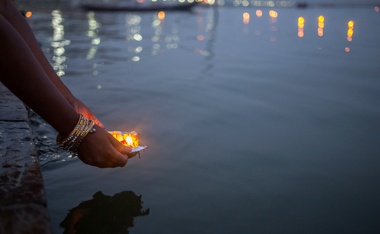







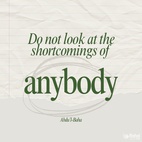
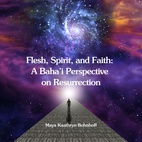
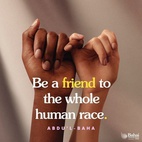
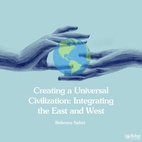
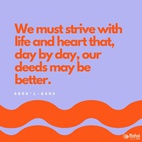

Amen. तत्त्वमसि tat tvam asi
The boy did.
"Where is that salt?" his father asked?
"I do not see it."
"Sip here. How does it taste?"
"Salty, father."
"And here? And there?"
"I taste salt everywhere."
"It is everywhere, though we see it not. Just so, dear one, the Self is everywhere, within all things, although we see it not. There is nothing that does not come from it. It is the truth; it is the Self supreme. You are that, Shvetaketu.
You Are That.”
― Eknath Easwaran, The Upanishads